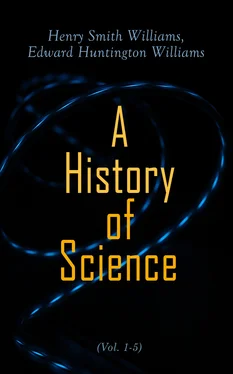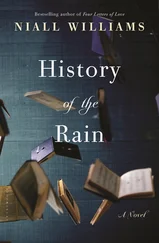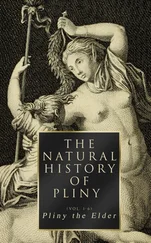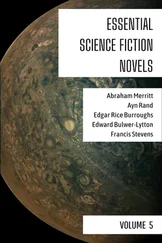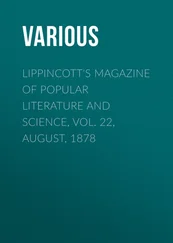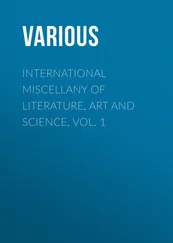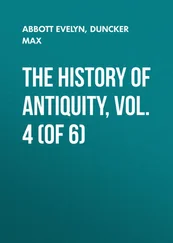CHAPTER II. EGYPTIAN SCIENCE
Table of Contents
1 (p. 34). Sir J. Norman Lockyer, The Dawn of Astronomy; a study of the temple worship and mythology of the ancient Egyptians, London, 1894.
2 (p. 43). G. Maspero, Histoire Ancie-nne des Peuples de l'Orient Classique, Paris, 1895. Translated as (1) The Dawn of Civilization, (2) The Struggle of the Nations, (3) The Passing of the Empires, 3 vols., London and New York, 1894–1900. Professor Maspero is one of the most famous of living Orientalists. His most important special studies have to do with Egyptology, but his writings cover the entire field of Oriental antiquity. He is a notable stylist, and his works are at once readable and authoritative.
3 (p. 44). Adolf Erman, Life in Ancient Egypt, London, 1894, p. 352. (Translated from the original German work entitled Aegypten und aegyptisches Leben in Alterthum, Tilbigen, 1887.) An altogether admirable work, full of interest for the general reader, though based on the most erudite studies.
4 (p. 47). Erman, op. cit., pp. 356, 357.
5 (p. 48). Erman, op. cit., p. 357. The work on Egyptian medicine here referred to is Georg Ebers' edition of an Egyptian document discovered by the explorer whose name it bears. It remains the most important source of our knowledge of Egyptian medicine. As mentioned in the text, this document dates from the eighteenth dynasty—that is to say, from about the fifteenth or sixteenth century, B.C., a relatively late period of Egyptian history.
6 (p. 49). Erman, op. cit., p. 357.
7 (p. 50). The History of Herodotus, pp. 85–90. There are numerous translations of the famous work of the "father of history," one of the most recent and authoritative being that of G. C. Macaulay, M.A., in two volumes, Macmillan & Co., London and New York, 1890.
8 (p. 50). The Historical Library of Diodorus the Sicilian, London, 1700. This most famous of ancient world histories is difficult to obtain in an English version. The most recently published translation known to the writer is that of G. Booth, London, 1814.
9 (p. 51). Erman, op. cit., p. 357.
10 (p. 52). The Papyrus Rhind is a sort of mathematical hand-book of the ancient Egyptians; it was made in the time of the Hyksos Kings (about 2000 B.C.), but is a copy of an older book. It is now preserved in the British Museum.
The most accessible recent sources of information as to the social conditions of the ancient Egyptians are the works of Maspero and Erman, above mentioned; and the various publications of W. M. Flinders Petrie, The Pyramids and Temples of Gizeh, London, 1883; Tanis I., London, 1885; Tanis H., Nebesheh, and Defe-nnel, London, 1887; Ten Years' Diggings, London, 1892; Syria and Egypt from the Tel-el-Amar-na Letters, London, 1898, etc. The various works of Professor Petrie, recording his explorations from year to year, give the fullest available insight into Egyptian archaeology.
CHAPTER III. SCIENCE OF BABYLONIA AND ASSYRIA
Table of Contents
1 (p. 57). The Medes. Some difference of opinion exists among historians as to the exact ethnic relations of the conquerors; the precise date of the fall of Nineveh is also in doubt.
2 (p. 57). Darius. The familiar Hebrew narrative ascribes the first Persian conquest of Babylon to Darius, but inscriptions of Cyrus and of Nabonidus, the Babylonian king, make it certain that Cyrus was the real conqueror. These inscriptions are preserved on cylinders of baked clay, of the type made familiar by the excavation of the past fifty years, and they are invaluable historical documents.
3 (p. 58). Berosus. The fragments of Berosus have been translated by L. P. Cory, and included in his Ancient Fragments of Phenician, Chaldean, Egyptian, and Other Writers, London, 1826, second edition, 1832.
4 (p. 58). Chaldean learning. Recent writers reserve the name Chaldean for the later period of Babylonian history—the time when the Greeks came in contact with the Mesopotamians—in contradistinction to the earlier periods which are revealed to us by the archaeological records.
5 (p. 59) King Sargon of Agade. The date given for this early king must not be accepted as absolute; but it is probably approximately correct.
6 (p. 59). Nippur. See the account of the early expeditions as recorded by the director, Dr. John P. Peters, Nippur, or explorations and adventures, etc., New York and London, 1897.
7 (p. 62). Fritz Hommel, Geschichte Babyloniens und Assyriens, Berlin, 1885.
8 (p. 63). R. Campbell Thompson, Reports of the Magicians and Astrologers of Nineveh and Babylon, London, 1900, p. xix.
9 (p. 64). George Smith, The Assyrian Canon, p. 21.
10 (p. 64). Thompson, op. cit., p. xix.
11 (p. 65). Thompson, op. cit., p. 2.
12 (p. 67). Thompson, op. cit., p. xvi.
13 (p. 68). Sextus Empiricus, author of Adversus Mathematicos, lived about 200 A.D.
14 (p. 68). R. Campbell Thompson, op. cit., p. xxiv.
15 (p. 72). Records of the Past (editor, Samuel Birch), Vol. III., p. 139.
16 (p. 72). Ibid., Vol. V., p. 16.
17 (p. 72). Quoted in Records of the Past, Vol. III., p. 143, from the Translations of the Society of Biblical Archeology, vol. II., p. 58.
18 (p. 73). Records of the Past, vol. L, p. 131.
19 (p. 73). Ibid., vol. V., p. 171.
20 (p. 74). Ibid., vol. V., p. 169.
21 (p. 74). Joachim Menant, La Bibliotheque du Palais de Ninive, Paris, 1880.
22 (p. 76). Code of Khamurabi. This famous inscription is on a block of black diorite nearly eight feet in height. It was discovered at Susa by the French expedition under M. de Morgan, in December, 1902. We quote the translation given in The Historians' History of the World, edited by Henry Smith Williams, London and New York, 1904, Vol. I, p. 510.
23 (p. 77). The Historical Library of Diodorus Siculus, p. 519.
24 (p. 82). George S. Goodspeed, PhD., History of the Babylonians and Assyrians, New York, 1902.
25 (p. 82). George Rawlinson, Great Oriental Monarchies, (second edition, London, 1871), Vol. III., pp. 75 ff.
Of the books mentioned above, that of Hommel is particularly full in reference to culture development; Goodspeed's small volume gives an excellent condensed account; the original documents as translated in the various volumes of Records of the Past are full of interest; and Menant's little book is altogether admirable. The work of excavation is still going on in old Babylonia, and newly discovered texts add from time to time to our knowledge, but A. H. Layard's Nineveh and its Remains (London, 1849) still has importance as a record of the most important early discoveries. The general histories of Antiquity of Duncker, Lenormant, Maspero, and Meyer give full treatment of Babylonian and Assyrian development. Special histories of Babylonia and Assyria, in addition to these named above, are Tiele's Babylonisch-Assyrische Geschichte (Zwei Tiele, Gotha, 1886–1888); Winckler's Geschichte Babyloniens und Assyriens (Berlin, 1885–1888), and Rogers' History of Babylonia and Assyria, New York and London, 1900, the last of which, however, deals almost exclusively with political history. Certain phases of science, particularly with reference to chronology and cosmology, are treated by Edward Meyer (Geschichte des Alterthum, Vol. I., Stuttgart, 1884), and by P. Jensen (Die Kosmologie der Babylonier, Strassburg, 1890), but no comprehensive specific treatment of the subject in its entirety has yet been attempted.
CHAPTER IV. THE DEVELOPMENT OF THE ALPHABET
Table of Contents
1 (p. 87). Vicomte E. de Rouge, Memoire sur l'Origine Egyptienne de l'Alphabet Phinicien, Paris, 1874.
2 (p. 88). See the various publications of Mr. Arthur Evans.
3 (p. 80). Aztec and Maya writing. These pictographs are still in the main undecipherable, and opinions differ as to the exact stage of development which they represent.
Читать дальше
